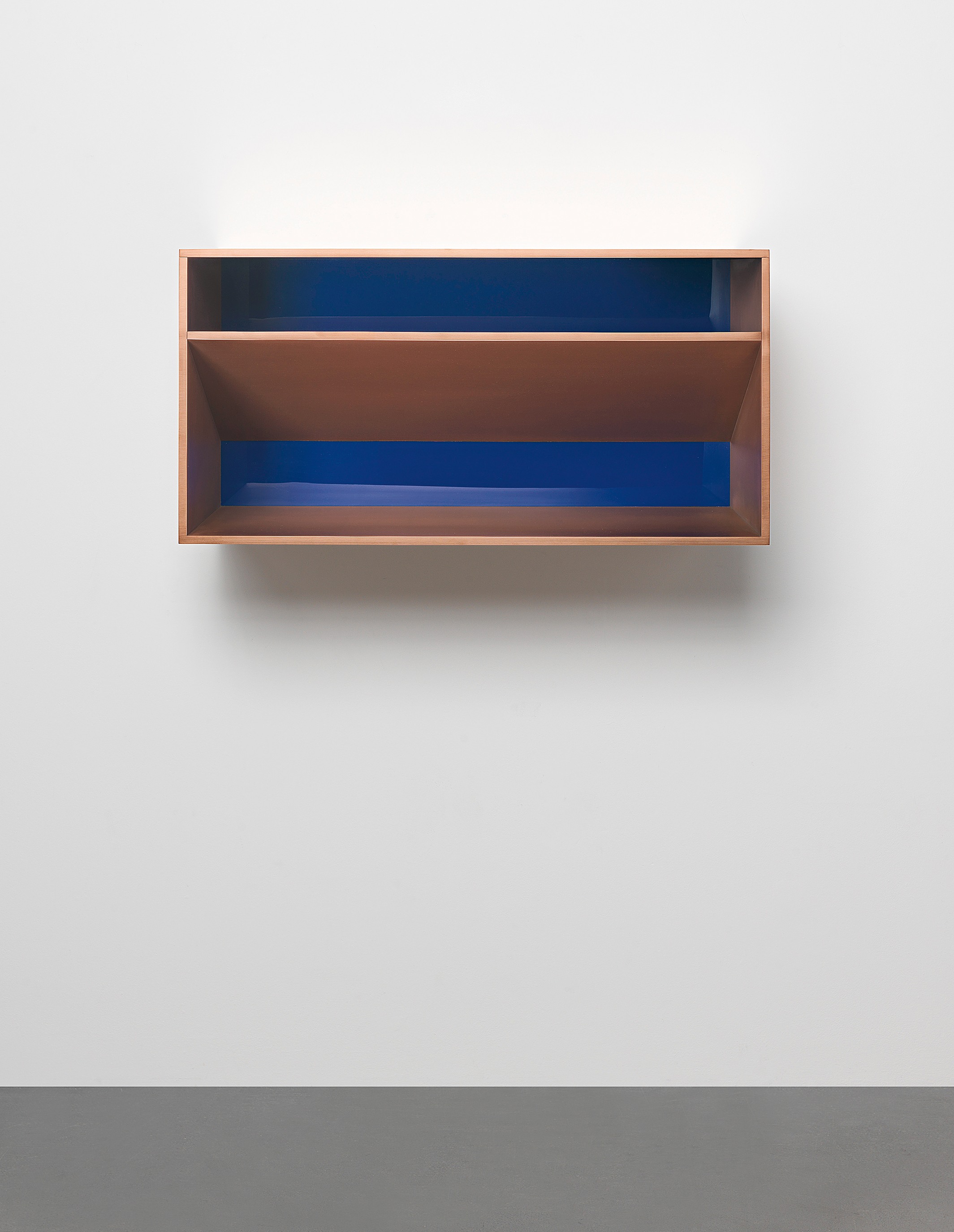



32
Donald Judd
Untitled
Full-Cataloguing
Resembling neither painting nor traditional relief sculpture, Untitled perfectly encapsulates Judd’s over three-decade long redefinition of the relationship between art object, viewer and surrounding space. Rejecting the illusionism of painting and seeking an aesthetic free from metaphorical associations, Judd came to critical acclaim in the 1960’s with his simple, yet revolutionary, three-dimensional floor and wall objects made from new industrial materials, such as anodized aluminum, plywood and Plexiglas. From the outset Judd delegated the fabrication of his works to specialized technicians, in particular working closely with the New York fabricator Bernstein Brothers. Untitled was the fourth object Judd made with the Bernstein Brothers in 1981. This discrete group of works represents the culmination of some of the most central formal themes that Judd had honed in the preceding two decades. Both the structure of the wall-mounted box and the inclusion of colored acrylic sheets are elements that originate from Judd’s basic vocabulary of forms he had developed in the mid-1960s, the combination of which he pursued with a series of self-framing, open horizontal wall boxes lined at the back with Plexiglas starting in 1974. The oblique interior planes similarly present a continuation of Judd’s experimentation with interior angular planes that he had initiated with a series of plywood and galvanized steel objects in 1974. It is, above all, the fusion of all these key innovations into a singular object that makes Untitled and its related works so distinct.
Untitled perfectly exemplifies Judd’s interest in experimenting with different colors, materials and forms to generate all-encompassing space. Judd explained as early as 1971 that, “the box with the Plexiglas inside is an attempt to make a definite second surface…While the outside is definite and rigorous, the inside is indefinite...I like to try other things to see what happens to the shape and surface. Also, I like to try different colors on the same form by using different materials” (Donald Judd, quoted in John Caplans, “An Interview with Don Judd”, Artforum, no. 9, June 1971, p. 44.). Exemplifying Judd’s unshakeable belief in the importance of color, the deep blue that emanates from Untitled speaks to Judd’s detailed study of color in the works of such artistic forebears as Rogier van der Weyden, Titian, Henri Matisse, Josef Albers, Mark Rothko. Up until 1984, Judd embraced a deliberately limited palette of red, blue and black in his pursuit to assimilate color, in the form of the acrylic sheet, as an inherent rather than superficial quality: “Color is like material. It is one way or another, but it obdurately exists. Its existence as it is is the main fact and not what it might mean” (Donald Judd, “Some Aspects of Color in General and Red and Black in Particular”, 1993, in Donald Judd Colorist, exh. cat., Sprengel Museum, Hannover, 2000, p. 114)
Judd’s selection of copper, as opposed to the typical aluminum, here heightens the interplay between color, material and space – its warm surface dissolves the sharp edges of the object’s geometric forms while simultaneously softening the reflective effects of the blue acrylic sheet. As in the seminal Untitled, 1972, which is the permanent collection of the Tate, London, and its companion piece from 1974 – two identically proportioned floor-based, open-topped copper boxes enameled respectively on the inside base with red and blue paint – the interaction between the copper surface and blue hue results in a spatial dispersion of color and light that expands beyond the boundaries of the object. In works such as the present one, the oblique plane above all serves to open up color into space. Epitomizing Judd’s dictum that “actual space is intrinsically more powerful and specific than paint on a flat surface,” Untitled elegantly articulates the artist’s unparalleled ability to engage the viewer in a sensorial experience in real time and space (Donald Judd, “Specific Objects,” 1964, in Arts Yearbook 8, 1965, p. 94).
Donald Judd
American | B. 1928 D. 1994Donald Judd came to critical acclaim in the 1960s with his simple, yet revolutionary, three-dimensional floor and wall objects made from new industrial materials, such as anodized aluminum, plywood and Plexiglas, which had no precedent in the visual arts. His oeuvre is characterized by the central constitutive elements of color, material and space. Rejecting the illusionism of painting and seeking an aesthetic freed from metaphorical associations, Judd sought to explore the relationship between art object, viewer and surrounding space with his so-called "specific objects." From the outset of his three-decade-long career, Judd delegated the fabrication to specialized technicians. Though associated with the minimalist movement, Judd did not wish to confine his practice to this categorization.
Inspired by architecture, the artist also designed and produced his own furniture, predominantly in wood, and eventually hired a diverse team of carpenters late in his career.